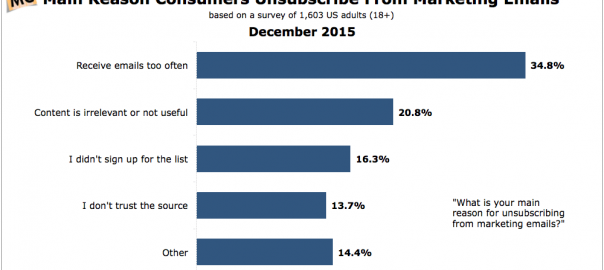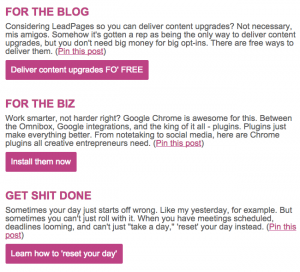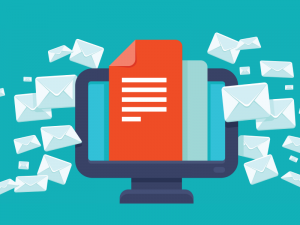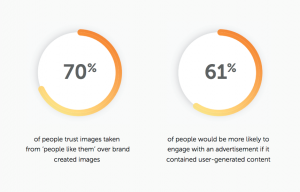What do information overload, brain freeze, and hangovers have in common?
Each one is an example of what happens when you get too much of a good thing. Whether we’ve swamped ourselves with news stories from Twitter, overindulged with a tub of Phish Food, or hit the town a bit too hard, we all know what it’s like to wish we hadn’t gone so far.
Today, we want to look at a common myth surrounding email marketing. Like our examples above, a conservative dose of effective email marketing can be a great thing. Too many emails, on the other hand, will give your list a severe headache.
Forget the bottle of aspirin, though. They’ll just unsubscribe.
Here’s our myth in a neat little package:
Too Many Emails Will Lead to a Spike in Unsubscribe Rates.
On one level that doesn’t sound like much of a myth. Every one of us struggles daily to reach that loftiest of goals: inbox zero. And we all know how frustrating it is when some inconsiderate email marketer distracts us from our seemingly impossible task.
So, when we look at charts like this one that show the #1 reason for email opt-outs is excessive frequency, we yawn and ask, “what else is new?” The principle seems obvious enough: If you talk too much, people will stop listening to you.

But is that principle correct?
TV show hosts like Stephen Colbert and Samantha Bee talk for a living, and yet millions of us tune in every night for more. Back to marketing—if people were genuinely excited to hear from you, do you think excessive email frequency would be their top concern?
So, if we’re going to get to the heart of today’s myth, we need to dig a little deeper and ask what else causes people to drop out… Well, I lied… We don’t have to dig that far at all.
The #2 reason people unsubscribe is that they find the emails to be irrelevant. Call me crazy, but that makes me wonder. Would the person who cited frequency as their top reason have been so quick to unsubscribe if they found real value in the emails they received?
On the flip side, was frequency just not an issue for the #2 respondents? In reality, we can’t isolate either question from the other. It seems our myth needs a little qualification.
What Counts as Too Many?

As a threshold, “too many” is too squishy to be helpful.
First off, different industries interact with email marketing in a variety of ways. According to Constant Contact, the average unsubscribe rate for fitness-related emails is a trim .08%. Landscapers, on the other hand, can expect .34% to opt out per email.
Unsubscribe rates don’t tell us the whole story, but they do tell us how we can expect subscribers to react to specific content categories. In other words, a spike in unsubscribes may have more to do with the nature of your campaign itself than the frequency of your contact.
Even more important than unsubscribe rates, however, are the expectations we set up for subscribers. If people sign up for your daily tip, weekly newsletter, or monthly update, then you’ve set a clear expectation. Go beyond that, and you may get yourself in trouble.
Content, Context, and the Health of Your List

If your campaign isn’t themed around a particular frequency, then the search for that magic threshold of too many is probably misguided. To be blunt, the problem isn’t with sending too many emails. It’s with sending too many irrelevant emails.
The relevance of your emails is a strand of three cords: content, context, and list health:
Content
This one is almost too obvious to be interesting. If you put together crummy emails that either misinform or fail to communicate anything worthwhile or helpful, then you can expect people to unsubscribe the minute you become annoying. When it comes to worthless emails, just one can be enough to turn people off.
Context
Know your list! It’s not enough for your content to be awesome; it needs to be awesomely relevant to your subscribers. If your list spans various demographics or interests, break it up via segment. Tailor your campaign to address their differing needs in specific ways.
List Health
Your list health is the measure of how well you’re doing pairing content and context. If your list is healthy—low bounce rate, high ratio of active users, high click-through percentage—then an uptick in frequency won’t be nearly as harmful as you might think.
Paradoxically, unsubscribes can help you increase the health of your list, but only if your content and context are in line.
Test, Test, Test
Once you’ve got the quality and relevancy of your email marketing in line, you can return to the frequency question. The best way to figure out how much email is too much is to test each campaign out before you run it.
In each of your segments, set aside a small control group—a segment within a segment, so to speak. Without leaving behind the relevancy question, you can then begin to experiment with an uptick in email frequency within those control groups.
Measure everything: click-through, conversion, and, of course, unsubscribe. If you find that people are engaging with your content and sticking with you, then you can be confident that your larger list can successfully bear an increase in frequency.
To be sure, every segment will have its breaking point. You can only push people too far before they begin to tune you out. The beauty of control-group testing is that you can find that breaking point without risking the bulk of your hard-earned list.
Conclusion
So back to our myth as originally stated: Too Many Emails Will Lead to a Spike in Unsubscribes.
As we’ve seen, this myth is false precisely because it asks the wrong question about why people unsubscribe. Instead of starting with questions about quantity, focus on the quality of your email marketing.
Do that, and you won’t have to worry nearly as much about frequency as you might think.
We’d love to hear from you. How’ve you dealt with email frequency in the past? Have you found unsubscribe rates to have more to do with frequency, relevancy, or list health?
Digital & Social Articles on Business 2 Community(31)









